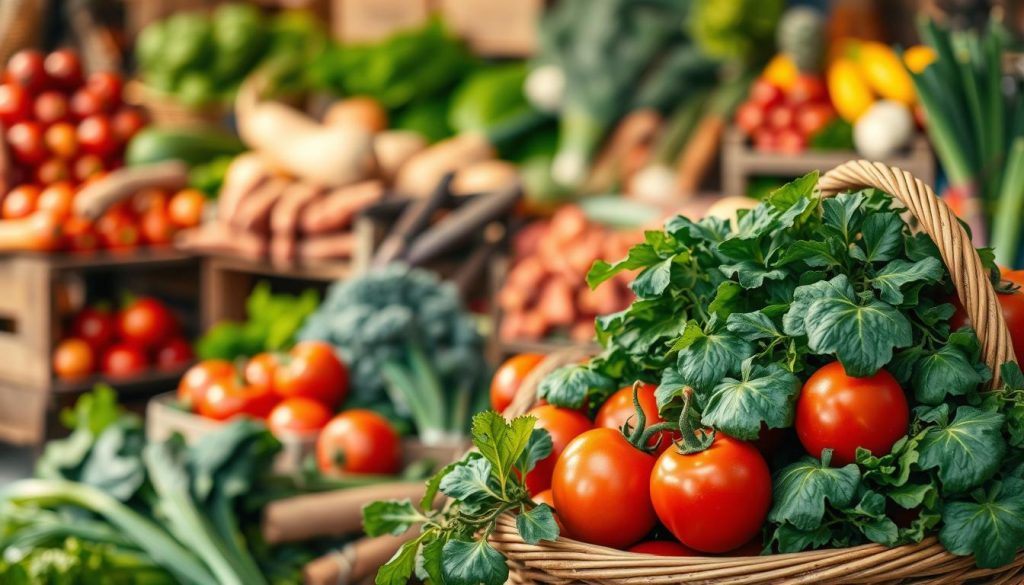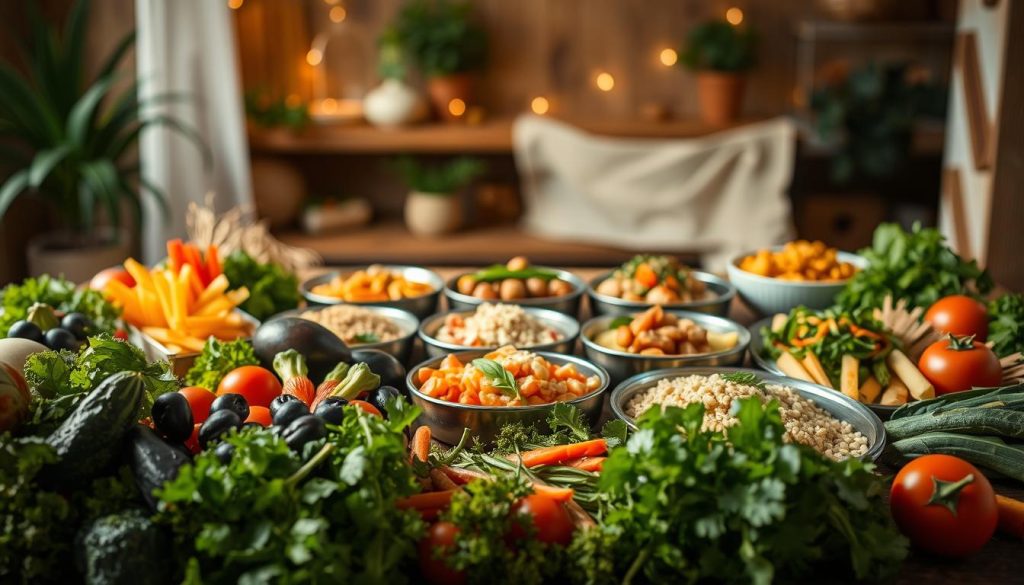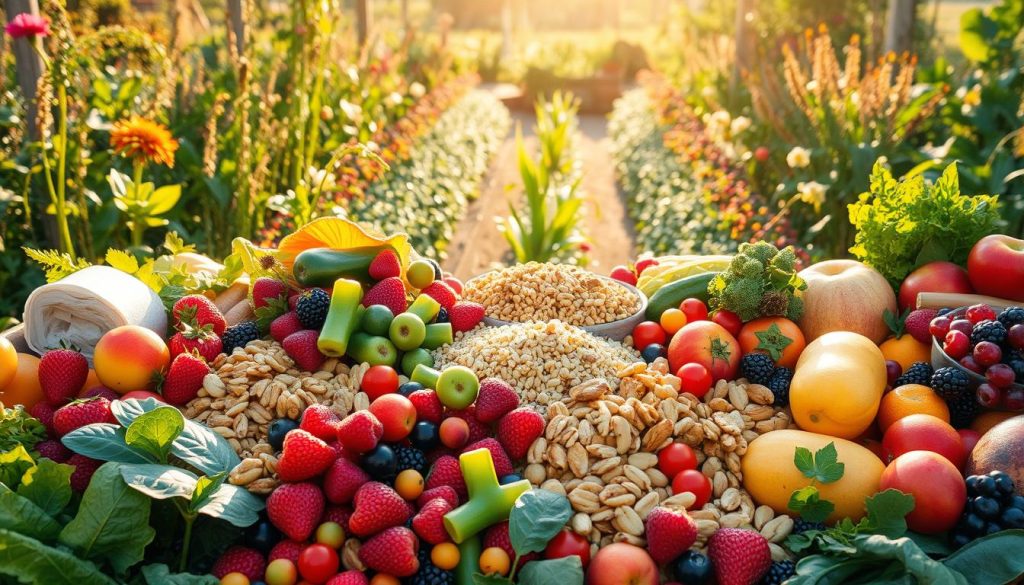Healthy foods are more than just meals. They are the foundation for a life full of energy and happiness. By choosing to eat nutritious foods, you turn simple choices into powerful tools for growth. Small changes in your diet can lead to big, lasting improvements in your health.
Key Takeaways
- Healthy foods fuel both body and mind, making daily life better.
- Nutritious eating is a long-term practice, not just a quick fix.
- Small changes today can lead to long-term well-being and energy.
- Every meal is an opportunity to nourish your body’s full capacity.
- This guide shows you how to make healthy choices easily.
The Power of Healthy Foods in Transforming Your Wellbeing
Every bite of healthy foods can change your day and future health. By choosing nutritious eating, you fuel your body and prepare for a better life. Let’s see how these choices lead to lasting changes.
How Nutrition Affects Your Physical Energy
Processed snacks might give a quick energy boost, but it fades fast. On the other hand, balanced nutrition from foods like quinoa, nuts, and greens gives steady energy. Here’s a comparison:
- Processed Foods: Sugar spikes → Energy crashes → Hunger soon after
- Whole Foods: Fiber + protein → Gradual energy release → Sustained focus
The Connection Between Diet and Mental Clarity
Did you know your gut talks to your brain? Foods like salmon and berries boost your brain. Studies show these foods can improve memory by up to 20% in adults over 50.*
| Nutrient | Key Food Sources | Brain Benefits |
|---|---|---|
| Omega-3s | Fatty fish, walnuts | Supports neural cell growth |
| Vitamin E | Almonds, spinach | Protects brain cell membranes |
Long-term Health Benefits of Nutritious Eating
Regular nutritious eating helps fight chronic diseases:
- Reduces heart disease risk by 30% (per CDC guidelines)
- Slows cognitive decline by supporting brain cell repair
- Improves metabolic health to delay age-related illnesses
Your choices today impact your future health. Every meal is a chance to invest in a healthier life.
Understanding What Makes Foods Truly Healthy
Choosing healthy foods isn’t easy. Terms like “natural” or “low-fat” can be misleading. Let’s get to the heart of what’s important.
Focus on whole foods—foods in their natural form or lightly processed. They keep vitamins, fiber, and antioxidants your body needs. On the other hand, ultra-processed foods are full of additives. Here’s how to tell them apart:
- Check ingredient lists: Shorter lists with recognizable ingredients = better.
- Avoid items with artificial colors, flavors, or preservatives.
- Opt for packaging that highlights “no added sugars” or “non-GMO.”
| Whole Foods | Processed Foods |
|---|---|
| Fresh fruits, vegetables, grains, and legumes | Snack bars, frozen dinners, sugary cereals |
| Rich in vitamins, minerals, and fiber | High in sodium, sugar, and unhealthy fats |
| Nutrient-dense: More nutrition per calorie | Calorie-dense but nutrient-poor |
A clean diet focuses on nutrient density. It’s about getting more vitamins from spinach than empty calories from chips. Every bite matters. Let’s move away from fleeting trends and focus on timeless principles that nourish your best self.
The Building Blocks of a Clean Diet
Starting a clean diet means picking foods that are good for your body. Focus on whole foods and the right mix of nutrients. This will give you energy and keep you feeling great. Let’s look at how each part helps you stay healthy.
Whole Foods vs. Processed Foods
Whole foods come straight from nature and are full of nutrients. Processed foods, though convenient, often lack the good stuff. Here’s how they compare:
- Whole foods: Fresh spinach, quinoa, almonds
- Processed foods: Packaged snacks, refined grains, sugary drinks
“Whole foods fuel without compromising,” says the USDA Dietary Guidelines. “They support health from the inside out.”
The Importance of Macronutrient Balance
Proteins, carbs, and fats are key for your body’s energy. Find the right mix for your lifestyle and goals:
| Macronutrient | Role | Whole Food Sources |
|---|---|---|
| Proteins | Muscle repair and growth | Lentils, wild salmon, tofu |
| Carbohydrates | Energy production | Steel-cut oats, sweet potatoes, brown rice |
| Fats | Cell function and satiety | Avocados, walnuts, olive oil |
Micronutrients: The Vital But Often Overlooked Components
Vitamins and minerals are small but mighty. They play a big role in your health. For example:
| Micronutrient | Role | Food Sources |
|---|---|---|
| Vitamin C | Immune support | Oranges, bell peppers, kale |
| Zinc | Immune function | Pumpkin seeds, chickpeas, yogurt |
| Vitamin D | Bone health | Fatty fish, fortified plant milk, sunlight |
Every bite matters. Choosing whole foods and making smart choices can lead to better health.
Organic Produce: Worth the Investment?
Choosing organic produce can seem tricky. Let’s simplify it to match your values and budget. Organic farming affects your health and the planet.

Environmental Benefits of Choosing Organic
Organic farming is good for the soil and nature. It avoids harmful pesticides, helping animals and keeping water clean. Buying organic produce helps our food system.
Understanding Pesticide Exposure and Health
Some foods, like apples or spinach, have more pesticide risks. But, not all are the same. Eating a clean diet means less exposure. The Environmental Working Group’s guides help you know where to spend or save.
Budget-Friendly Ways to Incorporate Organic Options
You don’t need to buy everything organic. Here are some tips:
- Buy organic for EWG’s “Dirty Dozen” (e.g., strawberries, spinach)
- Opt for conventional for “Clean Fifteen” items like avocados or onions
- Join a community-supported agriculture (CSA) for seasonal deals
| Best to Buy Organic | Okay to Buy Conventional |
|---|---|
| Apples | Avocados |
| Grapes | Pineapples |
| Peaches | Corn |
Every small choice counts. Focus on what’s important to you, like reducing pesticides or supporting local farms. Your choices lead to a healthier, greener life.
Plant-Based Eating: A Gateway to Vibrant Health
Exploring a plant-based diet opens doors to energy, vitality, and long-term wellness. Fruits, vegetables, legumes, and whole grains give us antioxidants, fiber, and minerals. They fuel our bodies without processed additives.
By choosing healthy foods, we lower inflammation and support heart health. Studies show lower risks of chronic diseases in plant-centric cultures.
“Diets rich in plant foods are linked to improved cardiovascular health and enhanced immune function.”
Shifting toward nutritious eating doesn’t need drastic changes. Start small by swapping meat in one meal a week with lentil soups or tofu stir-fries. Beans, quinoa, and spinach offer complete proteins, proving plant-based diets are not protein-limited.
Even a “flexitarian” approach—mostly plants with occasional animal products—brings benefits. Try black bean tacos for iron, experiment with chia seeds for omega-3s, and blend spinach into smoothies for extra nutrition.
- Try black bean tacos for iron-rich meals
- Experiment with chia seeds for omega-3s
- Blend spinach into smoothies for stealth nutrition
Celebrate the rainbow of plant-based options—purple beets, orange carrots, and green kale—each bursting with unique phytonutrients. Every bite is a step toward vibrant health, showing nourishment and enjoyment can go together.
Creating Balanced Nutrition in Your Daily Meals
Starting with mindful choices at every meal is key. Balanced nutrition isn’t about being perfect. It’s about making nutritious eating a natural part of your life. Let’s look at simple ways to make meals that boost your energy and taste great.

Breakfast Ideas That Fuel Your Day
Begin your day with meals that mix protein, fiber, and healthy fats. Here are some ideas:
- Avocado toast with poached eggs and spinach (adds heart-healthy fats and protein)
- Greek yogurt parfait layered with walnuts and seasonal fruit (rich in probiotics and antioxidants)
- Chia pudding made with almond milk and topped with cocoa nibs (a slow-digesting energy source)
Lunch and Dinner Combinations for Optimal Nutrition
For midday meals, follow this balanced nutrition guide:
| Protein | Vegetables | Grains |
|---|---|---|
| Salmon, tofu, or lentils | Kale, broccoli, or roasted Brussels sprouts | Quinoa, farro, or whole-grain rice |
Pair iron-rich foods like spinach with vitamin C sources (e.g., citrus) to boost nutrient absorption.
Smart Snacking for Sustained Energy
Snacks shouldn’t be empty calories. They’re chances to add nutrition to your day. Try these:
- Apple slices with almond butter (contains fiber, protein, and healthy fats)
- Hard-boiled eggs with carrot sticks (easy to prep and full of vitamins)
- Hummus with whole-grain pita and sliced veggies (balances carbs and protein)
These snacks keep hunger away and prevent energy drops.
Fresh Ingredients: The Foundation of Flavorful, Healthy Foods
Choosing fresh ingredients is more than just about taste. It’s key to nutritious eating. Produce picked at peak ripeness is packed with vitamins, antioxidants, and flavor. This is something processed foods can’t offer. Let’s see how to use this natural goodness for meals that are both healthy and delicious.
Seasonal Shopping Guide
Here’s a seasonal guide to help you pick the best healthy foods:
| Season | Top Picks |
|---|---|
| Spring | Asparagus, strawberries, peas |
| Summer | Tomatoes, corn, berries |
| Fall | Pumpkins, apples, Brussels sprouts |
| Winter | Citrus, pomegranates, root vegetables |
Preserving Nutritional Value in Food Preparation
Small changes can make a big difference. Here are some tips:
- Store herbs in water like cut flowers to stay crisp.
- Zap spinach in the microwave for 30 seconds to retain folate.
- Steaming vegetables instead of boiling cuts nutrient loss by 50%.
“Freshness is nature’s packaging. It delivers nutrition with zero preservatives.” — Dr. Emily Carter, USDA Nutrition Advisor
By focusing on freshness, you ensure your meals are full of life and health. Start by visiting your local farmers’ market or CSA. This way, you connect with the seasons and your health.
Transitioning to Healthier Eating: Practical Steps
Small changes can lead to big results. Starting a clean diet doesn’t mean you have to change everything at once. Focus on making progress, not aiming for perfection. Here’s how to start:
- Try the “crowd out” method: Add more healthy foods to your meals before cutting out less healthy options. Add spinach to omelets or choose carrot sticks over chips.
- Make healthier versions of your favorite foods: Use whole grains instead of refined ones. Try quinoa bowls instead of white rice or dark chocolate for dessert.
- Organize your kitchen: Fill your shelves with healthy staples like oats, canned beans, and frozen veggies. Get rid of expired snacks to avoid temptation.
| Strategy | Action Steps |
|---|---|
| Meal Prep | Batch-cook grains or chop veggies on Sunday evenings. |
| Cooking Skills | Learn 3 simple recipes (grilled chicken, stir-fry, salads) to boost your confidence. |
| Progress Tracking | Keep a 2-week journal to see how your taste preferences are shifting toward nutritious eating. |
“Change happens when what you do every day aligns with what you want.” — Unknown
Cooking at home can save money and give you more control. Start by adding one new ingredient each week. Replace sugary drinks with water or herbal tea every day. Celebrate with non-food rewards like a walk or a new playlist instead of using food for comfort.
Remember, lasting change takes time. Every choice you make brings you closer to feeling stronger and more energized. You’re on the right path—one nourishing bite at a time.
Overcoming Common Challenges When Adopting a Whole Foods Diet
Starting a clean diet is a big step towards better health. But, it’s normal to face challenges. Cravings, busy days, and social pressures can be tough. Let’s look at ways to turn these obstacles into chances for growth.
Dealing with Cravings and Food Addictions
Cravings often come from not getting enough nutrients or emotional reasons. Try eating healthier snacks like nuts or fruit instead of sugary ones. Drinking water and eating mindfully can also help. If you feel a craving, drink water and wait 10 minutes before acting on it.
- Swap processed snacks for whole foods like apple slices with almond butter.
- Keep track of your cravings in a journal to find patterns and solve the root cause.
Eating Healthy on a Busy Schedule
Even when you’re short on time, you can eat well. Spend a few hours on the weekend cooking grains, chopping veggies, and preparing healthy meals. Choose quick, nutritious meals like salads or grain bowls. Using pre-cut veggies or canned beans can save you time without sacrificing a clean diet.
Social Situations and Maintaining Your Nutrition Goals
It’s possible to stay on track at family gatherings or in restaurants. Plan ahead by bringing a healthy dish, like a veggie tray or quinoa salad. Say no to too much food and focus on eating in balance. Remember, one bad meal won’t ruin everything—enjoy it and keep moving forward.
“Progress, not perfection, defines a healthy foods journey. Small steps create lasting change.” – Dr. T. Colin Campbell, Nutritional Biochemist
Every challenge is a chance to improve. Celebrate your small victories and be kind to yourself. Over time, these tips will become second nature, making a whole foods diet a lasting part of your life.
Regional American Superfoods to Incorporate in Your Diet
Across America, healthy foods grow that feed both our bodies and communities. These foods are full of vitamins, antioxidants, and tastes that connect us to our lands. Let’s look at five superfoods that are rooted in tradition and care for our planet.
| Food | Region | Nutrition Highlights | Traditional Use |
|---|---|---|---|
| Wild Blueberries | Maine | Rich in vitamin C and anthocyanins | Used in Native American medicinal teas |
| Pawpaw | Appalachia | Natural source of vitamin B6 and magnesium | Pioneer settlers baked them into pies |
| Huckleberry | Pacific Northwest | High in fiber and manganese | Central to Indigenous ceremonies |
| Pecan | Southern States | Plant-based diet-friendly, loaded with healthy fats | Used in Southern desserts like pralines |
| Prickly Pear | Southwest | Antioxidant-rich fresh ingredients with anti-inflammatory properties | Harvested for centuries by Indigenous tribes |
“These foods are not just meals—they’re stories of resilience and connection to land,” says the Native American Food Sovereignty Alliance.
By picking these foods, we help local farmers and respect our ancestors’ wisdom. They grow well in our areas, needing less than foods from far away. Try mixing huckleberries into oatmeal or topping dishes with roasted pecans. Each bite honors America’s food history and supports a greener future.
Conclusion: Your Journey to a Vibrant Life Through Healthy Eating
Every bite of healthy foods you choose today shapes the energy and joy you experience tomorrow. This journey isn’t about rigid rules—it’s about nurturing your body with balanced nutrition that fuels your unique goals. Whether it’s a handful of berries or a leafy green salad, each choice is a step toward vitality.
Remember, nutritious eating starts small. Swap a soda for water, add a vegetable to your plate, or explore a new whole grain. These actions build momentum. There’s no perfect path—only progress. Let whole foods like local produce or plant-based proteins guide you toward a lifestyle that feels sustainable, not restrictive.
Together, we can redefine nourishment as a celebration of life’s possibilities. Share meals that energize, experiment with seasonal ingredients, and trust your body’s wisdom. Every healthy choice you make today is an investment in the future you deserve. Start now—grab an apple, plan a balanced meal, or simply hydrate. Your journey begins with one mindful decision at a time.


